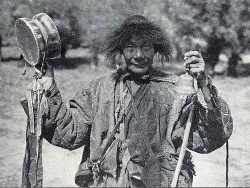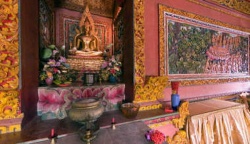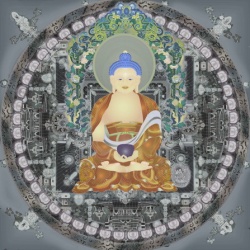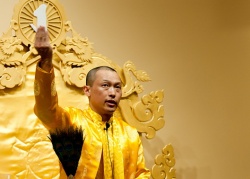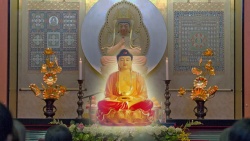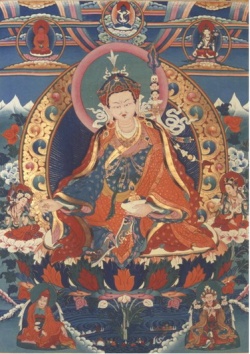The Buddha Jayanthi of 1956 and Buddhist Councils by Bodhicarini Upasika Jayasili Jacquetta Gomes
The Buddha Jayanthi of 1956 and Buddhist Councils
By Bodhicarini Upasika Jayasili Jacquetta Gomes BGKT Buddhist Group of Kendal (Theravada) England UK
Updated 12th September 2015
THE BUDDHA JAYANTHI OF 1956
The Buddha Jayanthi of 1956 commemorated the 2500th anniversary of the ‘Thrice-Blessed Event’ of Vesak, namely, (i) the birth, (ii) enlightenment, and (iii) Parinibbana (final passing away) of the Buddha. The Buddhist calendar commences with Parinibbana as the year zero. In Sri Lanka, Buddha Jayanthi was celebrated on a massive scale, 2500 youngsters being ordained as samaneras (novice bhikkhus (monks)) to mark the occasion.
However, for the five Theravada Buddhist countries of South-East Asia - Sri Lanka, Burma, Thailand, Laos and Cambodia - the most notable event was the sixth Buddhist Council (sangayama) held in Rangoon, Burma, from 1954-1956 to coincide with Buddha Jayanthi 1956.
Buddhist Councils (sangayama)
Buddhist Councils (sangayamas) have been held periodically through the centuries from the time of the Buddha’s Parinibbana. Their purpose is to rehearse (Sangayama means Rehearsal) and to ensure the continuity of the Buddha’s teachings in their pristine purity; and to ensure that no additions, deletions, alterations, or any other changes have been made by any of the five countries to their own copies of the Theravada Pali Buddhist Canon.
The first sangayama was held three months after the Parinibbana of the Buddha under the patronage of King Ajatasattu. The second sangayama was held a hundred years later when it was discovered that some bhikkhus were not following the monks’ rules laid down by the Buddha, such as not eating after the midday meal. Even after much remonstration the recalcitrant monks refused to conform to the vinaya rules. Eventually they broke away, formed a separate group and went their way.
The third sangayama was held around 250 BCE under the patronage of Emperor Asoka of India after his conversion to Buddhism. This sangayama had become necessary when it was discovered that Brahmins had infiltrated the Sangha. Their Brahmanical beliefs had crept into the Buddha’s teachings, and were being taught and practised as the teachings of the Buddha. At this sangayama a purge of the Sangha was carried out, and a large number of bhikkhus expelled.
The sixth (and last) Buddhist Council (sangayama) was held in Rangoon, Burma (Myanmar), from 1954 to 1956 under the patronage of the Burmese [Myanamar] government, to coincide with Buddha Jayanthi, 1956. Members of the Sangha from the five Theravada Buddhist countries of Sri Lanka, Burma, Thailand, Laos, and Cambodia attended this Council
Venerable Maha Kassapa, ‘Father of the Sangha’
The dying Buddha had told the monks gathered round his death bed that after his demise the Dhamma (teaching) itself will be their teacher. The monks knew by heart the six qualities of the Dhamma he had taught his followers during his 45-year ministry:
Svakkhato bhagavata dhammo - sanditthiko - akaliko - ehipassiko - opanayiko - paccattam veditabbo vinnuhi’ti - Well expounded is the Dhamma by the Blessed One - to be self-realised - with immediate fruit - inviting investigation - leading on to the Unconditioned (Nibbana) - to be comprehended by the wise, each for oneself.
Although the Buddha did not appoint anyone to lead the Sangha after his passing away, the mantle of leadership fell on Venerable Maha Kassapa, an austere, enlightened monk, who is affectionately regarded as ‘the Father of the Sangha’. He shunned living in monasteries, and lived in a forest with his followers. Venerable Maha Kassapa possessed the 32 ‘marks of a great man’ (maha purisa lakkhana) in common with the Buddha. He also had many qualities associated with the Buddha. An instance is recorded in the suttas where Venerable Maha Kassapa was once mistaken for the Buddha himself.
When news of the Buddha’s passing away reached Venerable Maha Kassapa in the forest, one of his followers, a monk who had entered the order only in his old age presumably to have an easy time, had expressed great satisfaction on hearing that the Buddha was no more because, he said, that meant there will be no more monks’ vinaya rules to be memorised and followed. The far-seeing Venerable Maha Kassapa, overhearing that foolish remark, realised that with such people entering the Sangha the teaching was not going to last for very long. He decided that early steps had to be taken for the preservation of the teaching for future generations.
The first Buddhist Council (sangayama)
Three months after the passing away of the Buddha, Venerable Maha Kassapa convened a meeting of 500 arahants (enlightened monks) in order to memorise and codify the teachings of the Buddha for the benefit of future generations. The vast body of oral teachings, which had been routinely memorised in chant form by the monks during the Buddha’s lifetime, were first figuratively placed in three baskets (pitakas). The Vinaya Pitaka, rules for monks, was placed in the first ‘basket’ as being the most important. The Sutta Pitaka, discourses of the Buddha, was placed in the second ‘basket’. Abhidhamma Pitaka, the psychological teachings, was placed in the third ‘basket’. The Theravada Pali Buddhist Canon is also known as the Tripitaka (the three baskets). Teams of monks were allocated for memorising different parts of the Tripitaka. The language was Pali, the language in which the Buddha had delivered his discourses.
After this first Buddhist Council, the oral tradition thus instituted had been transmitted in chant form down the centuries through generations of monks.
Emperor Asoka’s missions
In the third century BCE, when Emperor Asoka embraced Buddhism, he had sent missions to various countries including Sri Lanka. As King Devanampiyatissa of Sri Lanka was his good friend, the mission to Sri Lanka was headed by Emperor Asoka’s own son, Venerable Mahinda Thera, who arrived in Sri Lanka in 230 BCE, Venerable Mahinda Thera met King Devanampiyatissa and had a long discussion, asking the King various questions in order to assess his intelligence and suitability to receive the Buddha’s teachings. Satisfied with the king’s intelligence and his answers to the various questions which showed a quick wit, Venerable Mahinda Thera delivered to him the ‘Discourse on the Simile of the Elephant’s Footprint’. After the king’s conversion, the members of his court followed suit. Before long, the teachings of the Buddha had taken firm root in the island of Sri Lanka. The teachings continued to be transmitted in chant form by generations of monks.
The famine in Sri Lanka
Around 100 BCE, in the reign of King Valagamba, a famine decimated the population of the island. As the monks depended on the lay people for their food and other requisites, the monk population also suffered, and depleted in numbers. After the famine ended, King Valagamba decided that transmitting the teaching in oral tradition was unsafe, and ordered the teachings of the Buddha to be written down.
The Theravada Pali Buddhist Canon
The teachings were written down on ola palm leaves at Aluvihara, in the central hill country of Sri Lanka. This monumental task had taken 15 years. On a visit to Sri Lanka in 1997 I made a trip to Aluvihara to see where the Buddha’s teachings were first committed to writing. Aluvihara temple is situated in a sleepy little village still stuck in a bygone age, with bullock carts winding down the roads, buffalos ploughing the rice paddy fields, and people drawing water from wells. Time seems to have passed it by. In the large cave adjoining the temple where the writing had taken place, monks were still engaged in writing on ola palm leaves in the same old way, painstakingly inscribing the letters with a stylus and filling in the indentations with some kind of ink. I asked one of them to write my name on an ola leaf, which he was pleased to do. I put the leaf in my pocket, returned to Colombo and forgot all about it. A few days later I remembered that I had unfortunately washed the garment I had been wearing during my visit to Aluvihara in the washing machine. I fully expected the precious ola leaf and the writing to be completely ruined, but was astonished to find it in the same condition as when the monk handed it to me. This, to me, was the acid test. It strikes me that the method in which the Buddha’s teachings were first committed to writing in 100 BCE was far superior to our own 21st century printing.
Royal Patronage
The first five Councils were all held under royal patronage in India and Sri Lanka. The first sangayama was held three months after the Parinibbana of the Buddha under the patronage of King Ajatasattu; the second sangayama was held a hundred years later. The third sangayama was held around 250 BCE under the patronage of Emperor Asoka of India after his conversion to Buddhism, when, as described above, a purge of the Sangha was carried out.
The Buddha Jayanthi 1956 and The Sixth Buddhist Council (sangayama) 1954-1956
The sixth Buddhist Council (sangayama) was held in Rangoon, Burma (Myanmar), under the patronage of the Burmese (Myanmar) government to coincide with Buddha Jayanthi 1956. Members of the Sangha from the five Theravada Buddhist countries of Sri Lanka, Burma, Thailand, Laos, and Cambodia attended this Council. The written version of the Buddha’s teachings, known today as the Theravada Pali Buddhist Canon, had spread to Burma, Thailand, Laos and Cambodia. All five countries follow the same Canon.
The monks from the five countries compared their own copies of the Canon to ensure that no additions, deletions, or changes had crept into any of them during the interim period, and that the Theravada Pali Buddhist Canon continues to remain in its pristine purity.
European Bhikkhus (monks) at the sangayamas
Some scholars believe it is possible that Greek bhikkhus may have attended the Third Council held under the patronage of Emperor Asoka.
In 1952 the Burmese (Myanmar) government had invited Venerable Nyanatiloka Mahathera (1878-1957) (author of the Buddhist Dictionary: Manual of Buddhist Terms and Doctrines) and Venerable Nyanaponika Thera (1901-1994) for consultations about preparations for the Sixth Buddhist Council. They were both German nationals who had made Sri Lanka their permanent country of residence. After these consultations had been concluded, Venerable Nyanaponika Thera had remained in Burma for some time to undergo training in Vipassana Bhavana (Insight Meditation) under Venerable Mahasi Sayadaw Thera. Venerable Nyanaponika Thera subsequently wrote the best-selling The Heart of Buddhist Meditation published by the BPS Buddhist Publication Society.
In 1954, Venerable Nyanatiloka Thera and Venerable Nyanaponika Thera returned to Burma for the opening ceremonies of the Council. Venerable Nyanatiloka Thera was to have spoken at the closing session in 1956 but was too ill to attend. His speech was read out Venerable Nyanaponika Thera.
Venerable Ananda Maitreya Mahanayaka Thera Abhidhaja Maharatthaguru Aggamaha (1896 - 1998)
Venerable Ananda Maitreya of Sri Lanka was ordained as a novice on 2nd March 1911. His upasampada (higher ordination) was conducted on 14th July 1916. He was Mahanayaka (Head) of the Amarapura Nikaya of the Sangha in Sri Lanka, and played a prominent part at the historic sixth sangayama held in Rangoon in 1954-56. The Burmese government had asked the Sixth Council to produce an authorised version of the Tripitaka. Venerable Ananda Maitreya was the Sri Lankan representative on the final editing committee. He had also served as Chairman of the Council for a few weeks during the third session of the sangayama in 1956. The Burmese government subsequently conferred upon him the honorific title of Agga Mahapandita (‘Chief Great Scholar’). After his 100th birthday he received a special invitation from Burma where he received their highest religious title, Abhidhaja Maharatthagura (‘His Eminence, the Great Spiritual Teacher of the Nation’).
We are privileged to have had Venerable Ananda Maitreya as a founder Spiritual Advisor to BGKT Buddhist Group of Kendal (Theravada).
Source
By Bodhicarini Upasika Jayasili Jacquetta Gomes BGKT Buddhist Group of Kendal (Theravada) England UK
